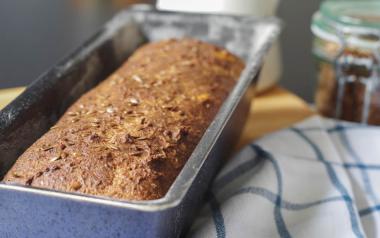Wouldn't you like to make a great loaf of gluten-free bread that isn't an endless and disappointing game of trial and error? As much as it would be great to simply substitute your favourite gluten-free flour for bread flour, it just doesn’t work that way! It takes a lot of patience, a willingness to try many variations of flour, and a bit of practice. But it can be done!
What does gluten do?
The problem is that gluten-free breads are missing one major ingredient: gluten! Gluten is the magic that helps baked goods rise, stretch, and have a nice chewy texture. Without it, breads tend to be dense and crumbly. Since there are no glutens in gluten-free baking (obvi!), the bread usually can’t rise or be kneaded like traditional bread. This means that gluten-free bakers have had to come up with a way that promotes the formation of gluten-like strands and cross-links, creating baked products that are chewier and less crumbly. This involves finding just the right combination of a few gluten-free flours and starches to make a similar product.
Making a good gluten-free bread
If you have an intolerance to gluten or an autoimmune disease like celiac, gluten must be avoided. But it doesn’t mean you still can’t have a great slice of toast or a killer sandwich!
Why should you make your own bread?
- Commercially made gluten-free breads contain a lot of sugar to compensate for the removal of gluten.
- If you’re vegan or have an egg allergy, store-bought GF bread might not be suitable.
- At upwards of $10 a loaf, these oftentimes inferior bread substitutes can be an expensive disappointment.
Being gluten-free doesn’t mean having to eat sugary, nutrient-weak breads! You can still have your "cake" and eat it too! Making your own gluten-free bread is a great, economical, and healthy way to ensure that the ingredients you’re ingesting are high in fibre, low in sugar, and still tastes delish!
Gluten-free flours to consider
Sorghum Flour
Sorghum flour is one of the best gluten-free flours out there for dietary fibre. This ancient grain contains 48% of your daily recommended intake of dietary fibre in a single (1 cup) serving! It’s full of great things like magnesium, protein, and is rich in antioxidants.
Millet
It’s not just for the birds! This seed makes a great addition to gluten-free baked goods, with its nice nutty flavour and ability to hold its own in a loaf of bread. It’s high in fibre, is easy to digest, and is low on the glycemic index.
Buckwheat
Contrary to its name, buckwheat isn’t a wheat at all: it’s related to rhubarb! The buckwheat seeds are used as a cereal grain, and can be ground to make flour. Perfect for use in gluten-free recipes, buckwheat makes a tasty addition to breads and adds a good amount of fibre, plus it’s believed that buckwheat can help lower cholesterol, can help prevent diabetes, aid in digestion, and is full of polyphenolic antioxidants, great for kicking those free-radicals' butts!
Tapioca
Tapioca Flour is made from the pulp of crushed cassava root, a shrub native to South America and the Caribbean. The terms tapioca flour and tapioca starch are used interchangeably and can be used as a GF thickener for sauces as well as in gluten-free baking, where it adds a hint of sweetness.
Easy Homemade Gluten-Free Bread
Dry ingredients
- ¾ cup millet flour
- ½ cup sorghum flour
- ¼ cup buckwheat flour
- ½ cup potato starch
- 1 cup tapioca starch
- 2 tsp xanthan gum
- 1 tsp salt
Wet ingredients
- 1¾ cup warm water
- 1 Tbsp active dry yeast
- 2 Tbsp honey or organic cane sugar
- 3 Tbsp olive oil
Instructions
- Preheat oven to 450°F.
- Grease a loaf pan with olive oil.
- Combine dry ingredients and set aside.
- Mix the yeast and honey into the water and set aside to activate for 10 minutes or so.
- Add the olive oil.
- Mix the wet ingredients into the dry, and combine well. It should look like a wet cake batter.
- Pour into loaf pan and let rise for 1½ hours.
- Bake at 450°F for 15 minutes, then lower the temperature to 375°F for 45-50 minutes.
- Remove from pan and let cool on a wire rack.
Enjoy as you would any bread (keeps for 3 days) or slice and freeze for up to 3 months!
*Originally published July 26, 2017








